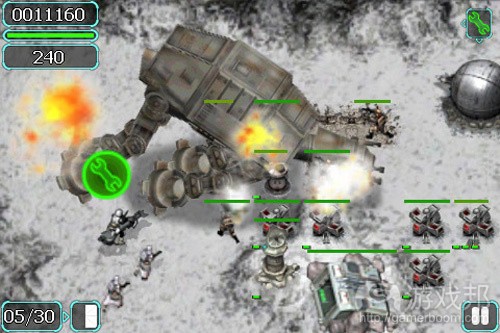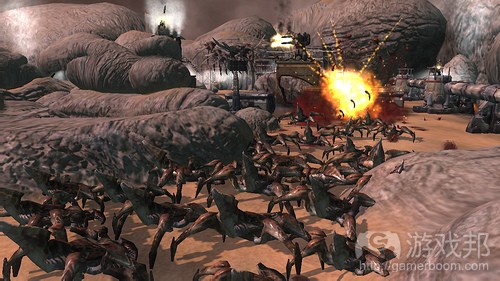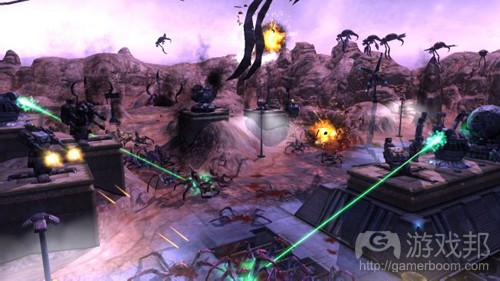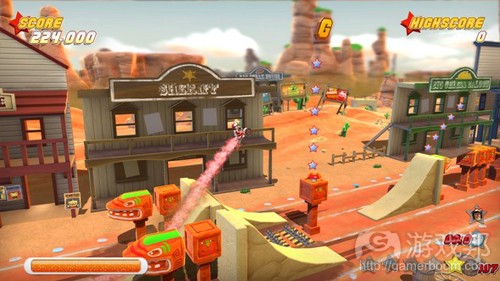万字长文,Tomas Rawlings谈独立游戏工作室创立环节
作者:Tomas Rawlings
第一环节,创意篇
过去数年间,互联网的连通性、Flash或UDK等简单可用的开发工具以及iPhone和Android之类新生平台逐渐融合,使得制作和发行游戏变得格外简单。某些人通过《愤怒的小鸟》或 《Minecraft》等简单却流行的游戏想法获得巨额财富,此类故事层出不穷。据称每个人心中至少都有个新颖的想法,那么能否也能将其转变成游戏呢?我将在下文中讨论如何将脑 中那些游戏想法提炼成可以分享甚至出售的可玩性体验。

idea(from candobizmag.wordpress.com)
本文关注的是开发过程中的创意层面,即想法和灵感。毫无疑问,制作游戏是个艰苦的工作,从游戏中盈利也很困难。然而,如果看到其他人从游戏中获得乐趣,再艰辛的付出也是值得的。
游戏制作有三个组成部分:游戏设计;呈现设计的图片和音效;将前两者融合起来的编程。目前Red Wasp Design有一个程序员、一个艺术师和一个设计师(游戏邦注:作者是Red Wasp Design的联合创始人,任工作室设计师一职),我们将音效设计外包。公司中每人身兼多职,程序员也可以做设计,但最终我们需要各职位人员密切配合才能将游戏制作出来
。
理想情况是,你单个人便可以完成至少一个职位的所有工作。如若不然,就需要找更多人来帮助你。我觉得让其他合作者加入会带来极大的好处,因为这样便有人分担你的职责, 而且他们也能给你提供想法和建议。如果你无法胜任上述职位之一,那就想想自己能为项目提供何种帮助。有些非核心职位可能造就一个工作室,比如营销或财务负责人。训练自 己成为可担当上述职位之一的人或许也有价值,这样你就能在会议上更好地表达自己的想法。
要去哪里寻找此等冒险行为的合作者呢?如果你正在学习某游戏或技术课程,那么就在周围找找看。大学通常也会开设艺术、编程或设计课程。张贴布告,让志同道合的人与你联 系。你也可以参加mod或开源开发群体聚会,志趣相投的人会为现有游戏或新游戏制作内容,这是个获得经验和面见同龄同趣人士的绝妙方法。
组建起开发团队后,下一步就需要决定制作游戏的类型。在考虑游戏制作之前,你首先需要的是某些出色的游戏想法。通常来讲,你不应采用那些其他人已经广泛采用的游戏想法 。目前有大量开发商正在制作《FarmVille》式的游戏,该题材也有很多发展机遇。然而,除非你是此类游戏的狂热粉丝,否则很难有足够的灵感来制作出某些特别且能够脱颖而出 游戏。坚持做目前已较为熟悉的方向,专注于设计那些玩家会购买的游戏。
在社交场合中,他人必然会询问“何以维持生计?”这个问题,当我表示自己是个游戏设计师时,时常会有人在后续的讨论中向我阐述他们的奇妙游戏想法。然而,只有少数能真 正称得上游戏创意,多数充其量只是可在其中设置游戏的叙事背景而已。如果你觉得故事最为重要的话,我不认为你是站在游戏制作的角度思考问题,因为它也可以被拍摄成电影 。尽管游戏中可以承载故事而且能够从故事中获益,但许多游戏并不真正依赖于故事,缺乏故事也不会影响到那些游戏巨作。《俄罗斯方块》中有什么故事?那些方块因何从天而 降?没有人关心这个问题,但它依然是众人喜爱的益智游戏。《现代战争2》这部游戏巨作的故事连贯性不是很好,但丝毫不影响我付费购买光盘一遍遍地玩。《潜龙谍影》的故事 不甚明了,我跳过剧情和对话直接体验极具吸引力的内容——游戏可玩性。
或许听起来有点匪夷所思,但萌生精妙游戏想法的关键在于思考游戏的核心机制。核心机制可比作游戏的心脏,指的是玩家在游戏世界中控制的东西以及此类控制的含义。《愤怒 的小鸟》的核心机制是弹射物体以击中目标。作为玩家,我需要控制的是弹射的力度和角度,这便是核心机制。在《星球大战:霍斯战役》中,当敌人变得越发强大且开始反击时 ,玩家可以放置的单位种类也随之增多。我们还要注意次级游戏机制这个层次,这些构建于整体体验之上的机制会增加游戏的可玩性。次级机制需要起到补充作用,不可损害到核 心机制。在《愤怒的小鸟》中,与某些鸟类功能的互动属于次级机制。我们也在《星球大战:霍斯战役》中添加了资源搜集部分和单位的AI控制。
尽管对好游戏而言想法至关重要,但这也是整个开发过程中最简单的环节。产生新想法很简单,灵光一闪有时只需数秒时间。想法的执行却要麻烦得多,可能要花上数个月时间。 因而你完全可以自由处理自己的想法,将它们共享、记录、丢弃或融合均可。只要有想法产生,我就会把它记下来,我在iPod上留了个便签页面记录游戏想法。记录往往只需要数 秒钟时间,但足以让我回想起自己的想法。这意味着,我随时都有大量可拓展的想法。我知道许多想法都不怎么样,但我希望在这个列表中总有些可以构建出游戏的精华。
你也应该将想法与团队成员分享,听听其他游戏开发者的意见,将自负心抛到九霄云外。想法是否采纳的主要评判标准不是该想法出自何人,而是想法有多好。留心你以及团队表 达想法所采用的系统,在游戏项目开发过程中,你需要将更多想法融入游戏中。
最后,扩大灵感来源的深度和广度。玩大量游戏固然没有错,但还应该注意其他艺术、文学、电视、电影和日常生活,这些都有可能给你带来灵感。游戏想法可能随时在随处出现 ,做好捕捉这些想法的准备正是你的工作!
第二环节,商业篇
今天我们就从商业角度谈论游戏工作室创建。文章并未囊括所有议题,也称不上游戏制作简要指南。制作游戏需要大量繁琐工作,但看到玩家从中获得乐趣让我们觉得所有付出都 值得。
我首先要谈的是游戏是项业务。经营任何业务都具有挑战性,管理工作不属于游戏制作,但是个必不可少的内容。若游戏无需以盈利为目的,那么尽情享受创作乐趣。有些模块图 像和开源团队就以此为工作目标。开发者是否需着眼创作乐趣,将工作当作爱好?
即便你将游戏视作业务,也应首先让其成为爱好,创工作氛围,你才会愿意为游戏掏钱。你最好掏钱买份《小行星大冒险2》,尝试制作游戏,看看自己是否适合开发工作,而不是 告诉老板如何制作,所有工作瞄准创收,最后你会发现你所认为的游戏设计其实和实际情况相左。
若你想要把游戏设计变成业务,你就要清楚自己要运作何种游戏游戏。这里有个古老的谚语:低耗、高质和快速,只能任选其二。我认为这也适用游戏工作室。你能够耗费少量资 金快速制作游戏,但作品定难以达到上乘质量。你或许能够制作高质量作品,但其必定需耗费更多资源,因而需投入更多成本。通过制作大量游戏以期获得成功符合常理。《愤怒 的小鸟》开发商(游戏邦注:即Rovio)早前就已推出52款游戏。重要的是参与人员需明白工作室属于什么类型,要朝何处发展。
现在我们就来谈谈投资。制作全新也许两个月(简单作品),也许1年多(更复杂的作品)。在这期间,你和你的团队需要开销。你要付出的成本包括时间、所需设备和营销预算。 不要认为游戏仅凭质量就获得广泛销路。若作品不巧碰上数百款应用同时发行,那么要从中脱颖而出绝非易事。即便是简单作品,也至少需要准备5000美元用于打广告和开展其他 营销活动。营销预算对新游戏的成功来说非常重要。这里我只能说开发者应给予大量关注,这和游戏开发本身同样重要。
你可以选择利用工作之余制作游戏,但从我的经验来看,如果你希望将此发展成某项业务,仅把它当作爱好是不够的,只将少数精力用于游戏开发最终只会带来不良结果,开发进 度将每况愈下。不仅如此,若你想要通过开发游戏谋生,就要投入更多精力。这意味着你需要资金支撑项目。
幸运的是,和其他业务不同,游戏开发只要投入少量资金。只需人手一台电脑,若干开发软件及其他零星费用(游戏邦注:例如,苹果iOS开发者每年支付100美元授权费)。和开 餐厅比较你就会明白我的意思。最大的成本在于你支付给自己的酬劳。在投入项目前,你也需要将自身成本降至最低。除吃住外你还需要什么?哪些奢侈享受是你所不需要的?虽 然你已筹集足够资金支持项目进展,但世事难料,你需要留有调整空间。
你可以选择节省部分资金,所以当你退出项目时仍有资本。你可以尝试从IndieGoGo之类网站筹集资金。你也可以先投入能够带来些许营收的项目,或者寻求外部资助展开项目。例 如,我目前正协助在英国开发者大会成立座谈小组,创建Wellcome Trust组织,旨在给生物科学主题游戏提供资金帮助。

Battle for Hoth from gawkerassets.com
你也可以选择受雇他人,开始自己的游戏开发生涯(游戏邦注:如帮助发行商制作游戏,从中获利)。你将需要我们之前谈到的创意和构思,但在这里你的创意和构思是用于服务 他人。你可以根据现有作品进行构思,就像《Star Wars: The Battle for Hoth》,或者向发行商提出新构思,获得他们的融资,就像《Savage Moon》。这些都是艰苦工作,你首 先需同发行商联系,因为仅向他们提出构想很难有所收获。你需要同他们面对面交谈,发表你的看法,至少需要传递大概设计构想(大概1页)和简短视频(大概10秒钟),呈现游 戏最终形态。有些发行商需要更多内容,如演示文本或构思画面。记住还有很多开发者在争取他们的投资,所有你需要确保能够在他们中脱颖而出。

Savage Moon from aeropause.com
你可以在E3游戏展、科隆游戏展以及开发者大会等活动碰到发行商。参加大会需支付相应费用(通常1000多美元),但如果这能够换来10万美元合同,那么一切都值得。进入大会 ,你需要进行系列社交活动,若没有预约,发行商通常不会让你进入他们的个人展台。办法之一就是参加发行商代表的演讲大会,随后在重要会议中表达自己的祝贺,询问自己能 否同他们交流,谁是沟通最佳人选。再来就是留心观察他人ID名牌,若你发现一同排队等咖啡的人是发行商,就试着展开交谈。你需要进行系列闲聊,不是所有人都具备该技能, 所以如果你缺乏该技能,可又希望采取此策略,需要同团队其他具备该能力的人讨教。这个办法确实有效,我们就是采用此办法使我们的初创工作室同索尼公司达成合作协议。
这里我还得谈谈社交媒介,Twitter和LinkedIn是很好的社交工具,你应该充分利用,但他们不过是面对面交流的补充工具,所以记住你无法仅对着PC屏幕就完成所有工作。
谈到这里,你应该知道如何争取合作开发商,如何构想有望发展成热门作品的游戏创意,学习运作游戏工作室,明白如何融资。我最后想说的是希望你能够从中有所启发。
第三环节,营销篇
你的营销方法取决于你是何种类型的游戏开发者(游戏邦注:为其他工作室工作还是自行发行游戏),但无论属于哪种情况,你都需要直接与游戏玩家交流。

Savage Moon(from ps3.gamezone.com)
我们在《Savage Moon》中的此类交流动态颇有借鉴意义,这是款我为索尼开发的PS3游戏。我们(游戏邦注:指代开发者)会收到玩家的邮件,里面写有他们的问题和想法。索尼 给出的官方建议是,将这些问题提交给客户服务部门。现在我能理解为何公司会采取这种做法,他们与我们合作共同制作游戏,却把握不准我们在与顾客交流时会有何种态度。我 不否认或许我们会批评或抱怨某些差劲的粉丝。但以我的观点来看,把这些有关我所设计的游戏的问题递交给其他人是种很奇怪的做法。我当然对游戏的了解要比他们多得多,也 就更可能解决问题。
营销与优秀游戏的设计一样,无固定的成功之路可行。营销的创意性与游戏本身的创意性同等重要。网络上有成千上万的游戏供潜在玩家选择,因而你需要时常自问,为何玩家要 选择你的游戏呢?态度、平台和背景之类所有你与玩家交流的内容都对潜在粉丝的获取至关重要。
本篇文章将提出些许营销关键点,我认为或许能够有所帮助。而且,由于我也是刚刚开始接触这个领域,因而欢迎所有读者分享他们自己的观点、想法和经验。这些营销建议的前 提是你并不像《使命召唤:黑色行动》那样能花上1亿美元来做营销(游戏邦注:该游戏的营销成本是开发成本的4倍)。
首先,我认为目前你还无法自行发布商业化游戏并期待能够让游戏自行推广。你需要营销预算,也就是说你应该准备在营销上花些钱。那么,为何要仅仅为忽略向人们介绍游戏的 过程而耗费时间和精力呢?回到上述《使命召唤:黑色行动》这个例子,4:1的比例或许对你的工作室来说是个理想比例,但拥有如此庞大预算的工作室并不多。你需要募集些许金 钱,精确定位广告能帮上你的忙。参与关键的大会或广告赞助等项目,这种机会也不容错过。只要你有营销游戏的想法,就肯定有人付费为你买单,这样你应该就能募集营销所需 资金了。
其次,你需要考虑的是营销计划。你需要制定许多计划。比如,对于游戏如何从只有你一个人知晓发展成拥有足够的粉丝知道并愿意购买游戏,直至你可以用盈利来维持生计,你 都需要制定出整体计划。广义上来说,这项计划应该包含两部分内容:你的直接交流计划和间接交流计划。直接交流指那些你可以控制的渠道,如工作室的网站和博客、Facebook 页面和Twitter等。如果可以的话,你还应该关注发行商的网站和博客等。
间接交流指那些可能有兴趣报道你的工作室和游戏的渠道,但他们与你并无瓜葛,也没有义务这么做。这些渠道包括游戏网站(游戏邦注:如Gamezebo)、博客、杂志、游戏粉丝 网站等。你的计划中应该包含找到渠道负责人讨论游戏报道相关事宜的方法。

joe-danger(from vikingfunk.com)
应该更关注直接交流,你可以在游戏还未完成时便开始操作。Hello Games的做法是个绝佳的例证,人们在工作室首次发布《Joe Danger》时发博文并讨论来构建起粉丝群体,这样 当他们在PSN上发布游戏时,首日便足以收回开发成本。这方面有个技巧,你正在开展的与更新相关的讨论话题,应该是你们团队的开发目标。这是种保持粉丝了解游戏开发进程的 有效方法。
相比之下,如果采用间接交流,人们不会对你所做的每件事情感兴趣。因而,在游戏开发之初便要开始计划营销,在整个开发过程中用交流吸引玩家关注。引起公众关注可以采用 多种方法,包括依靠发行商、游戏预告、发布截图或视频、发布测试版和发布游戏的最终版本。
在所有交流过程中,你需要时刻明白自己的身份和你所说的事情。我想说的是,让这种交流简单一些,不要让其承载过多的内容。然而,事实上你需要通过在线的交流来分享自身 的感受。对我而言,也就是像公众分享你的激情,这对游戏开发者来说很简单。以博主Robert Scoble为例,他在担任微软雇员的时候便开始撰写博客,而且不像其他的企业博主, 他写的是自身的想法。当然,谈论微软产品是他的工作之一,但他也会批判团队的错误做法和褒赏竞争者的产品。结果他成了最受欢迎的博主,为微软赢得了许多用户的青睐。
那么社交媒体又如何呢?当然,我认为这也是个很有效的途径,但因为现在所有人都这么做,那么我们又回到了上面提过的问题,那就是如何突出重围呢?在书籍《What Would Google Do?》中,Jeff Jarvis表示终极营销行为便是你无需采取任何行动。为什么呢?因为产品或服务确实非常棒,顾客会自行为你喝彩。事实上,良好的顾客便是你的营销团队 。核心问题在于现在我们正处在交流科技异常发达的世界中,“好事不出门,坏事传千里”的效果已经被放大了。当我们在Facebook或Twitter上发表动态时,其他人可以转播或赞 ,这样他们的朋友也可能这么做,如此循环下去。社交媒体可同时放大积极层面和消极层面。别把社交媒体当成是单向传播,这是个双向过程,你也应该倾听他人想法并做出回应 。而且必须记住的是,你不应该仅仅在不断营销自己的游戏,而应该成为网络中活跃的分子。
在本文结尾之际,我想再说说间接交流渠道,即游戏网站之类的渠道。你需要细心平衡对待游戏媒体的方式。他们也有着自己的想法,知道如何帮你找到平衡点。他们固然是通过 广告来盈利,但他们也需要保持内容的独立性,不被广告过分侵蚀,否则如何吸引玩家访问网站呢?或许你觉得自己的游戏很完美,但获得的评论却很差,那么你就需要处理这个 问题。不可强迫他们将评论更改成你想看到的结果,在游戏行业历史上,发行商或开发商攻击评论人员是最愚蠢的做法。差评是正常的,不是每个评论员都会喜欢你所制作的每款 游戏。你应该着眼于与这些间接交流渠道的长期合作,比如像他们提供带有截图的新游戏介绍等来让他们报道。
自行发行游戏是项很艰巨的工作,游戏市场非常拥挤,但也是这种竞争性驱动我们不断做出更好的游戏。作为一句玩家,我真为这种现象感到高兴!
相关拓展阅读:篇目1,篇目2,篇目3(本文由游戏邦编译,转载请注明来源,或咨询微信zhengjintiao)
How to Start a Games Development Studio
Tomas Rawlings
Over the last few years a combination of the connectivity offered by the Internet, easily available development tools such as Flash or UDK, and a proliferation of new platforms such as iPhone and Android has meant that making and publishing games has never been easier. Stories abound of a handful of people who have made their fortunes from simple yet popular games ideas such as Angry Birds or Minecraft. It has been said that we all have at least one novel inside us – does that translate to games too? I am going to take a look at how we might extract those games ideas from your head into playable experiences you can share or sell.
This blog article looks at the creative side of the process, about the ideas and inspiration. The next article I’ll be contributing is about the business side of starting a new studio. Neither is an exhaustive list of all the issues nor a fool-proof guide to making it. Make no mistake; making games is hard work, and making money from games is tough. However the reward of seeing other people getting pleasure from your game and giving them a slice of fun makes the hard slog feel worth it.Games are made from a combination of a design for the game, artwork and sounds that represent that design and programming to bring it together. Currently at Red Wasp Design we have one programmer, one artist and one designer (me!) and we’re outsourcing the sound design. One person can have multiple roles. For example, a programmer might also do the design, but ultimately you need all of these roles covered to make your game happen.
Ideally you’ll be in a position to do at least one of the roles. If not, you need to find more people to join you. For that you’ll either need to hire them or get them to join you at the start as a partner in the project. In many ways I think it’s a huge advantage to have others join you as partners in this sort of venture, as it shares the responsibility around and gives you others to bounce ideas and suggestions off of. If you’re not in a position to do at least one of the roles; then ask yourself what are you offering? There are other non-core roles that can still make or break a studio such as marketing or
finance. It might also be worth training up to be able to do one of these roles, so you are better able to represent your ideas around the table.
Where can you find partners for this venture? If you’re a student on a games or technology course, then look around you. Universities and the like will often have arts, programming or design courses. Stick some posters up asking for like minded people to contact you. You can also get involved in the mod scene or the open source development scene, where like-minded people meet to make content for existing games or indeed new games – it’s a great way to get
experience and meet fellow enthusiasts.
Assuming you’ve been able to assemble a team of people, next you need to know what sort of a game you wish to make. Before you can consider making games, you need to have some great ideas for games. In general I think you should avoid ideas for games that are following where everyone else is going. Currently lots of developers are making FarmVille-type games and there is lots of opportunity in that genre. However unless you’re a huge fan of them, you’ll
struggle to be inspired enough to make something really special that will stand out. Stick to what you know for now and worry about making the sort of games you would buy.
One of the most common conversations I have in social situations after I’ve had the inevitable “what do you do for a living?” question and I’ve answered, “I’m a games designer,” is the follow up discussion where they tell me about their amazing idea for a game. However very rarely is it an idea for a game, more often than not it is a narrative setting in which you might place a game. But it could also be a film, and if you’re thinking story first a foremost, I
’m not sure you’re in the right place to be making games. This is not meant to be mean – it’s just that while games can have a story and can benefit from a story, many games don’t need them nor fail to be great games without them. What is the story in Tetris? Why are these blocks falling from the sky? Nobody cares, because it’s an amazing puzzle game. Modern Warfare 2; amazing game but the story was a little disconnected. That didn’t stop me from paying cold
hard cash for a copy and playing it over and over. Metal Gear Solid; what is the story there? I have no idea. I lost the plot ages ago and skipped the dialogue to get to the good stuff; the gameplay.
This might sound off the point, but key to generating a great game idea is to be thinking of the game’s core mechanic. The core mechanic is the thing at the heart of the game that we as the player get to control and what that control means in the game world. In Angry Birds the core mechanic is flinging objects to take out targets. As the player I get to control the strength and angle of the flinging. That’s the core mechanic. In Star Wars: The Battle for Hoth I can place objects in the landscape that shoot to stop other target units from routing between two points. As a player I get to control the type and position of the objects I place. This placement strategy forms the core mechanic.
Once you’ve got the core mechanic, you then start to add variation to this. So in Angry Birds it starts to vary the type and function of the Birds while making the targets stronger and more complex. In Star Wars: The Battle for Hoth, the player gets more types of units to place while the enemy gets stronger and starts to shoot back. Then we can look to layer in secondary game mechanics; these are additional gameplay devices that build on the overall experience.
Secondary mechanics need to complement and not detract from the core mechanic. In Angry Birds, it is about adding an interaction to the functionality of the additional bird types. In Star Wars: Battle for Hoth we added a resource collection component and also AI controls for the units.
Ideas, while vital to good games, are in many ways the easiest of the whole process. It’s easy to think of new ideas, taking only seconds to have a light- bulb moment. Implementing the idea is the tough bit, and that can take months. So be free with your ideas, share them, write them down, drop them, remix them. Whenever I have an idea, I jot it down; I keep a note page on my iPod with games ideas on. Just a few words on each, but enough to remind me of what I was thinking about. This means I’ve always got lots of ideas handy to tap into (mine has 40 odd ideas on it currently). I know lots of them will be rubbish, but within that list I hope there are some uncut gems we can build upon.
Ideas should also be a shared resource with the team, listening to your fellow games developers’ own ideas and pushing your ego into the background so that the main criteria for the adoption of an idea is not who generated it, but how good it is. Take note of the systems you and your team are generating to arrive at an idea; as a game development project progresses, you’ll need more ideas within that game. The same process you’re developing here should serve
you well at these other points too.
Finally, draw deep and wide for inspiration. Yes, play lots of games but also look to art, literature, TV, films and everyday life to inspire you. A brilliant idea can come from anywhere and at any time – it’s your job to be ready to catch it!
My last blog article looked at the creative side and if you’ve not read it yet, I’d suggest starting there. Now let’s look at the business side of starting a games studio. Again note; neither is an exhaustive list of all the issues nor a fool-proof guide to making games. Making games requires lots of hard work, but the pay-off of seeing people having fun with your creation is often worth it.
The first point I should make here is about games as a business; running any business is very challenging and ultimately the time spent administering it is time not spent making games, but still an essential requirement. If you’re in a position that you don’t need to make games for money, then make them for the pleasure of creation. There are mod scenes and open source development groups doing just that – might it be right for you to concentrate on the fun creative bit and treat it as a hobby?
Even if you want to do this as a business, it might be worth spending a little time making games as a hobby first to get a vibe for the work before you spend any of your own money on such a venture. Better that you spend a little money buying a copy of LittleBigPlanet 2 to make a game in there to discover if development is right for you, than to you tell your boss where to shove it and leave your job to make millions in gaming only to discover that the version in
your head of what it is like to make games is not what the reality turns out to be…
If you are going to make a business of it then you need a vision for what sort of a games business you wish to run. There is an old adage that goes; cheap, quality, fast – pick two. I think it applies to a games studio too. You can make games quickly and for not much money, but they won’t be the best quality. You can make amazing quality games but they take many more resources to produce and so cost more. There is nothing wrong with playing the numbers game of
trying to get lots of titles out there. The developer behind Angry Birds made 52 games before they had a huge hit. What is important is that all involved know what sort of a studio you are and what sort of a vision to have.
Now let’s talk investment. Making a game from scratch is going to take anything from 2 months for a simple title to over a year for a more complex one. During that time you and your team still need to eat and pay the bills. What costs you need to plan for are the cost of your time plus the equipment needed to make the game, and also a budget for marketing. Don’t be tempted to think that the quality of the game alone will sell itself. It might if you are very lucky, but with hundreds of apps being released per day, standing out from the crowd is hard. Even for a simple title I think you need at least a budget of $5000 to use for ads and other marketing activity. This area is vital to the success of any new game and needs more space to talk about it than I can put in this article. Suffice to say it needs serious consideration and is as important as the development itself.
You can work on the game during your spare time while you earn a living, but my experience is that if you are trying to make a business and not do it just as a hobby, the energy drain of doing your normal work on top of the new venture soon takes its toll and development will drop off. Not only that, but if your new venture is going to be your income, you will take it much more seriously. That means you need some money to bankroll the project.
Fortunately, unlike many other businesses, making games has few capital costs. All you need is a computer each, some development software and a few other bits (for example, it’s $100 per year for an Apple iOS developer licence). Compare that to the cost of setting up a restaurant and you’ll see what I mean. The biggest cost is how to pay yourselves while you make the game. Before you embark on this venture you also need to get your personal costs down to a minimum; what do you need beyond food and shelter? What is a luxury you can do without? Even if you’ve got the money to bankroll you for what you plan to be the development time, things don’t always go according to plan and you may need room to manoeuvre.
You can simply save the money up so you’ve got some capital before you quit your job. You can try to raise investment from sites like IndieGoGo. You can also make your first project something that earns you a little money or look for grants to help you start. For example, I’m helping to produce a panel at the Develop conference in the UK where an organisation called the Wellcome Trust is giving away grants for games ideas that engage people in the topic of
biomedical sciences.
You can also look to start as developers for hire; making games for publishers to earn money. You still need the creativity and ideas we talked about, but here you’re putting those in the service of somebody else. This can mean either pitching games ideas around existing Intellectual Property (IP) as we did with Star Wars: The Battle for Hoth or pitching new ideas to publishers hoping they will fund them (as we did with Savage Moon). Both are hard work and firstly you need the contacts with publishers as I doubt you’d get anywhere simply sending in your ideas to them. You need face-to-face meetings where you can pitch ideas, and even then as a minimum you need an outline design for the idea/s (about one page of text) and a short video (10+ seconds) showing what the final game might look like. Some publishers ask more, such as a demo or concept art. Remember, they have lots of developers looking to get them to fund
their games, so you’ve got to stand out from this crowd.
You can meet publishers as events like E3, Gamescom or Develop. It costs to get a pass to be able to go into the business areas of the show (often over $1000), but given this might lead to a $100,000 contact, it can be worth it. Once inside you need to do lots of networking, as most publishers will not allow you in to their private booths without an appointment. One method is to attend talks where representatives of publishers are speaking, then congratulate them
after on a great session and ask if you can pitch to them and if not who is the best person to speak to. Another is to keep looking at everyone’s’ ID badges and if you spot that the person in the queue for coffee with you is from a publisher, strike up a conversation. You need to be doing lots of schmoozing and chatting, and it’s not a skill everyone has, so if you’ve not got it and you want to go down this route then you need to get somebody in your team who has. And it does work; we got our contracts with Sony for the first games studio I was involved with from just such means.
I should also mention social media here; things like Twitter and LinkedIn are a great means of networking and you should use them, however they only really complement the face-to-face networking, so note that you can’t do all of it from behind a PC screen.
By now you should have an idea of how to get fellow developers to work with you, generate ideas that will become hit games, a strategy of how you are going to run this games studio of yours, and thoughts about how you’re going to get the money to run it. My final point then is that I hope it works out for you. Yes it means I’ll be in competition with you, but great games are great games and one day I hope to be playing a title you’ve created and thinking, ‘Wow, I wish I’d thought of that!’
Tomas Rawlings is a games designer and consultant. He co-founded Red Wasp Design and is Creative Director at Auroch Digital. He is currently producing amongst other things, a panel at the Develop Conference in the UK where you can find out more about making games.
Of the three arenas of starting your own games studio (see my past articles for the creative and business sides), marketing is the area where I’m most out of my comfort zone. I’ve been working in the games industry for a fairly long time, and for most of that time us developers had very little to do with the public facing side of games. We made the games and the publisher handled the marketing side of things. As the reach of the Internet grew and the cost of
communication dropped to almost zero, that situation began to change. As a developer we started to get players by-passing the publisher to contact us directly. This trend accelerated as new publishing platforms such as iPhone and Facebook opened up gaming even further.
In many ways, your approach to marketing is going to depend on what sort of a games developer you are (such as work-for-hire or a self-publishing one) but either way, to some extent you’ll need to be prepared to talk directly to the players of your games.An instructive experience with this communications dynamic came with Savage Moon, a PS3 title I designed, developed for Sony. We (the developer) would get emails from people with questions and ideas. The official advice from Sony was to pass that query on to their customer services department. Now I understand why they’d do it that way, they worked with us to make games and had no idea what we were like at communicating with their customers. We might go a bit crazy at a hint of criticism and rant at some poor fan. However from my point of view, it felt a bit odd to have to pass a question about a game I’d designed on to somebody else as I knew more about the subject than they did of course. It’s an issue that big companies need to engage with – how to empower individuals to have a real honest voice while managing the risk they might say something that reflects badly on all involved or accidentally reveal
something they should not have. (Shh, don’t tell anyone but I replied to all of the emails we got directly!)
Much like the design of a great game, there is no one clear route to success. Being creative about marketing is as important as being creative with the game itself. There is always much more going online for potential fans than they can ever look at, so you have to always ask yourself, why would anyone bother listening to what you’ve got to say? As such, all the content of your communications; the manner, platform and context, are all vital to getting potential
fans to tune in.
This article has a few key pointers on marketing that I think may help. Equally, as this is an area new to me also, anyone reading who wishes to share their own views, ideas and experiences, is greatly welcomed. I’m also assuming that you don’t have $100 million, which is the sort of marketing spend that a game like Call of Duty: Black Ops would have (interestingly about 4 times the development cost).
Firstly, I don’t think you can currently self-release a commercial game and hope that word of mouth alone will make it happen for you. You’ll need a marketing budget, and I feel you should expect to spend some money on marketing. After all, why spend time and effort making a game only to ignore the process of telling people about it? Back to the example of Call of Duty: Black Ops; that 4:1 ratio would ideally be the case with your studio, but not many have that kind of budget. You will need to find some money – well targeted adverts can work really well. Opportunities to attend a key event or sponsor something can really pay off. As you develop ideas for marketing, some will inevitably cost and you should have some sort of reserve of cash you can use.
Next consider planning, planning and planning. Did I mention planning? Good. You’ll need a number of plans. For example, you need to have an overall plan for how to get from the starting point of just you knowing about the game to the end point of having enough fans who both know about it and who are willing to buy your game so you can make a living. Broadly this plan should have two parts; your direct communications plan and your indirect communications plan. Direct communications are those channels where you have a strong degree of access and control, such as your studio’s website and blog, your Facebook pages, Twitter feeds etc. You might include your publishers sites, blogs and feeds here too if they are able to give you access (e.g. A post promoting a game on Sony’s blog looks like this).
The indirect communications channels are defined as outlets that may be interested in covering your studio and its games but who are independent of you so are under no obligation to do so. This is a wide range of channels from games sites (like Gamezebo!), blogs, magazines, fan sites and the like. Your plan needs to have an approach to each of these outlets to find the right person there to be talking to about getting coverage.
Looking more at the direct communication, it is important that you don’t wait until the game is completed before you start. A great example of how this can be done properly is the Hello Games people who blogged, chatted, attended events etc to build up a fan-base for their first release ‘Joe Danger’ so when it released on PSN, they sold more than enough to make back the development costs in day one. A rule of thumb here is that this ongoing communication is about
regular updates that should talk about what you and the team are up to. It’s a way of keeping fans informed on ongoing progress.
By contrast, with indirect communications they are not going to be interested in every single thing you do, so plan your marketing to start early and engage people throughout the period of development. You’ll have some key points where you might be able to generate spikes in publicity; signing to a publisher, announcing a game, release of screenshots or videos, releasing a demo and finally releasing the game. Add into your plan when these bigger mail-outs are
going to happen and to whom you’ll send press releases.
In all of your communications you need to be clear in both who you are and what you are saying. I’d say to keep it simple and don’t try to load too much into each burst of communications. However in effect your online ‘voice’ needs to reflect, well, you. To me it is about sharing your enthusiasm, which is easy when you are people who’ve created what you are now selling to the world! Take for example the blogger Robert Scoble, he started blogging whilst being an employee at Microsoft and took an unusual line for a corporate blogger of being himself. Of course he would talk about Microsoft’s products as was part of his job, but he’d also criticise them when he felt they’d gone wrong and he’d praise competitors’ products too. As a result he became hugely popular and generated a surge of goodwill towards Microsoft.
What about social media? Of course, as a minimum I’d expect a strong presence here, but given everyone is doing that too, we are back to the same problem of how do you stand out from the crowd? In the book ‘What Would Google Do?’, Jeff Jarvis says that the ultimate marketing campaign would be one you don’t need to do at all. Why? Because the product or service is so good and so well made that your customers would be creating the buzz for you. In effect good
customers become your marketing team. The core thing about the mesh of communications’ technologies we have around us, and the old adage of a happy customer tells 1 friend but an unhappy customer tells 10, is amplified. When we post on Facebook or Twitter, others can see it and Retweet or Like it, opening up the post to their friends and followers and so on. Social media amplifies and it can happen to both the positive and negative. Don’t treat social media as if it
is something one-way where you just talk; it is a two-way process where you should be listening and responding too. Also remember that it’s a series of interlocked communities, so you should be about more than just selling your game and become an active member.
I want to end this article by coming back to the indirect communication channels; games sites and the like. You need to balance how you deal with games media carefully. They have their own pressures and understanding that will help you to find that balance. They make money from adverts, yes, but they also need to keep editorial independence, or else why would gamers read them? You may think your game is a 10/10 mega-hit and get annoyed at a bad review, but you need to deal with it. Don’t try to pressure them into saying what you think they should say – some of the worst PR blunders in gaming history involve publishers or developers attacking reviewers. Bad reviews are part of the territory; there is no way that every reviewer will love every game you make. You should be aiming to develop long term relationships with these indirect sources based on a mutual respect; you can offer them good access to new titles with screenshots etc and they offer you coverage.
And with that, I’m off back to work on our new studio’s game…. Self-publishing games is hard work; it’s a very crowded space, but that competition drives us to make better and better games. Which as a gamer – I’ always in favour of! Good luck!
上一篇:复古风的兴起(一):RTS的先驱
下一篇:创建自己的游戏工作室的72个建议







































 闽公网安备35020302001549号
闽公网安备35020302001549号